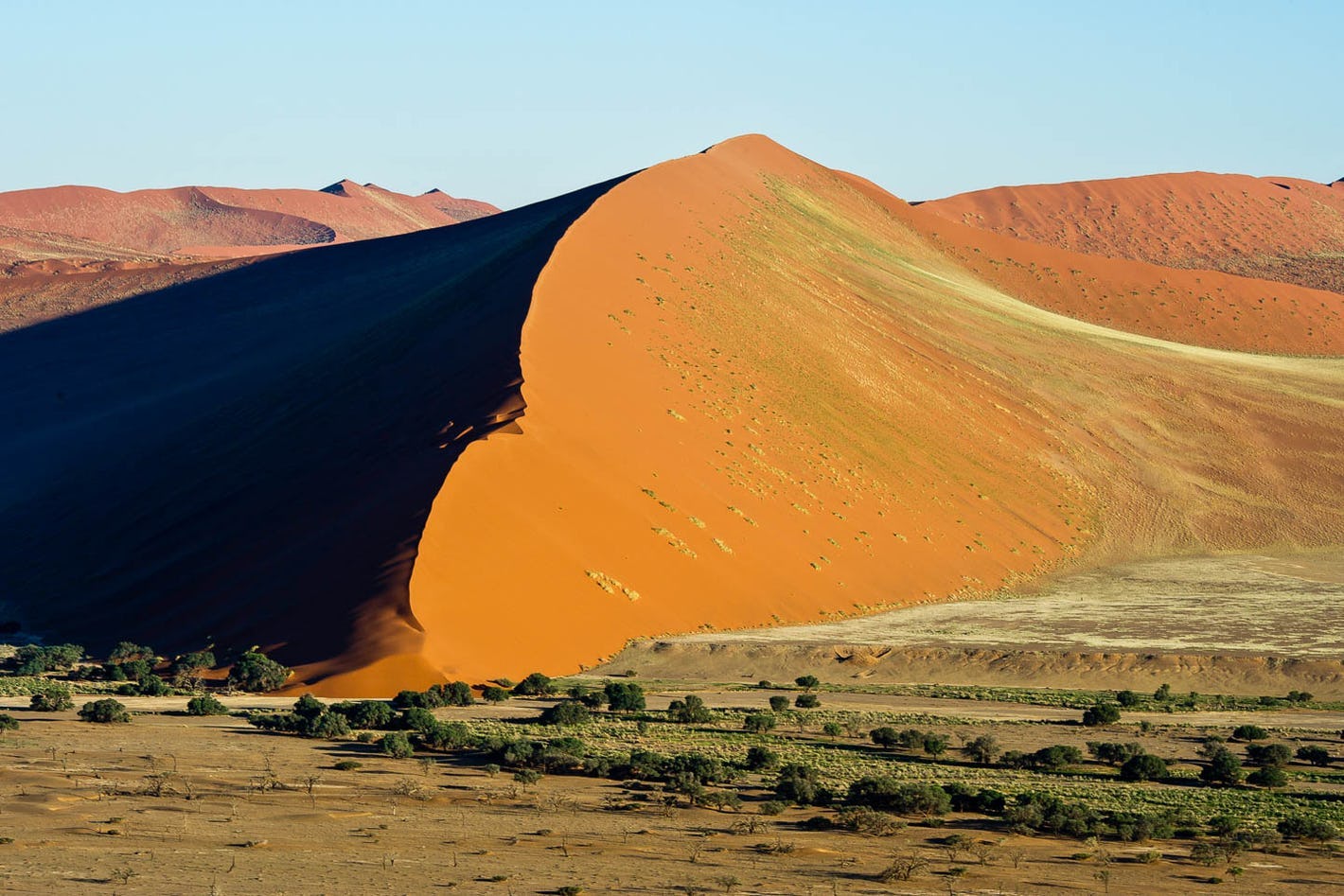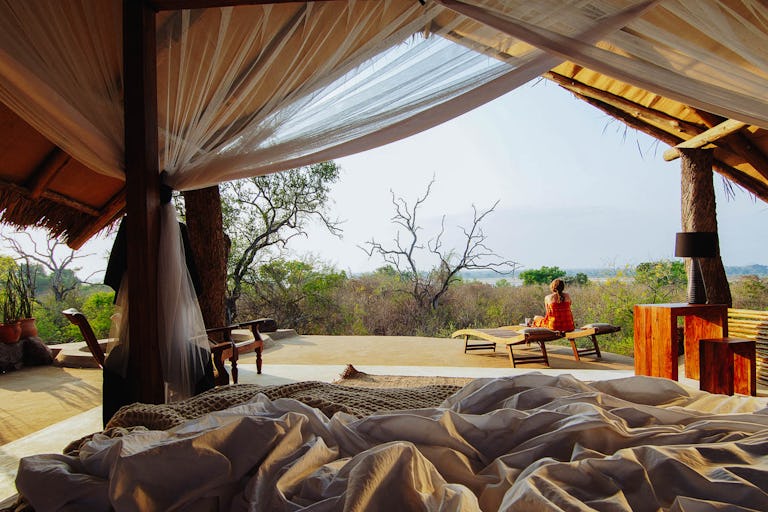
Visit the Kingdom in the Sky for amazing alpine scenery and a charming culture not many know about.

Chat to an expert
Design your own trip
Customize one of our recommended trips or design your own from scratch

About Lesotho
If we could say one thing about Lesotho, it would be that it’s astoundingly underrated. The tiny kingdom is in fact an independent country surrounded completely by South Africa, yet the two couldn’t be more different. Lesotho is a wild, mountainous place (the lowest altitude is 1000 metres above sea level, believe it or not!), with superlative-laden alpine scenery around every precipitous corner. Most travellers on a Lesotho holiday explore the country on multi-day treks through its dramatic hills and traditional villages, on foot or atop a hardy pony. But if you have a day or two either side, don’t leave in a rush – this is a place for taking it slow and enjoying the legendary hospitality and culture of the local Basotho people.
/28.232748,-29.446414,3/620x353@2x?access_token=pk.eyJ1IjoidGltYnVrdHV0cmF2ZWwiLCJhIjoiY2poMGw1eHpkMmRkbDJ6bW8xYWZ5OGpjYyJ9.PYvAO7lUJ40SOpGvwmQLqw&attribution=false&logo=false)
Why you'll love it
You might not know what to expect, but that’s the beauty of Lesotho. The magic is in its intrigue, and a Lesotho holiday is about spectacular scenery, new activities, warm people and discovering things you didn’t even know existed.
Off the beaten track
Horse racing is big in Lesotho. In fact, it could well be described as a way of life! If you happen to be visiting on a Saturday, head to Semonkong for one of the best races in the country, and join the crowds to watch the horses and riders jostle and "tripple" (that's like speed walking, for those less knowledgeable about matters equine) their way down the track.
Something to think about
You won’t find any fancy accommodation here; instead, you’ll be treated to cosy mountain lodges with hearty food and even heartier hospitality – and really, that’s better than all the sophistication in the world.
Where to stay
When to go
Mountainous Lesotho has some of the most extreme temperatures on the continent, with the mercury reaching plus-40 degrees in the height of summer (January and February), and snow lying on the ground in the depths of winter (June and July)! For general sightseeing, hiking and exploring, the autumn months of March, April and May, and the end of winter and into spring (September to November) are pleasant and balmy and show the kingdom at its best. If you decide to take the plunge and visit in summer to coincide with a trip around South Africa, you’ll be pleased to hear the humidity is low year-round and although the temperatures are scorching, it’s a bearable, dry heat. In winter (June, July and August), the days are cold but usually clear and sunny and it’s a great time of year for skiing – just remember a scarf and gloves!
Need to know
Essential information before you leave
Getting there
Getting there
Lesotho is completely landlocked by South Africa and, whether you travel by land or air, it will be the starting point. The easiest and most popular route is a one-hour flight from O R Tambo International Airport (JNB) in Johannesburg, landing at the Moshoeshoe I International Airport (MSU), which sits approximately 18 km west of the capital, Maseru.
Lesotho can also be reached via multiple land borders should you be on a self-driving or privately-driven trip. Many require a 4WD vehicle including the most scenic route, Sani Pass, which leads out of the South African province of KwaZulu-Natal.
Whether you fly or drive into Lesotho, there are no domestic flights once there and the best way to travel is by road or on a trekking or horseback journey (for the truly adventurous).
Health & Safety
Health & Safety
Please consult your personal physician and/or a travel clinic preferably 6 weeks prior to your departure. Vaccine requirements vary based on your country of origin and your travel itinerary and your previous vaccination history. It is best to consult with your physician or the CDC website for guidelines.
Important vaccinations to consider and which may either be required or recommended are: Hepatitis A & B, tetanus, rabies and typhoid, among others.
Yellow Fever
There is no risk of Yellow Fever in Lesotho; however, vaccination is required for travellers who are arriving from, or have transited through, countries with risk of Yellow Fever transmission (e.g. Kenya, Uganda, Rwanda or elsewhere worldwide). This requirement can change unexpectedly, therefore, we recommend carrying a Yellow Fever card with you at all times.
Communication
Lesotho country code: +266
Calling overseas from Lesotho:
From a landline dial 00 followed by the country code plus area code and number.
e.g. USA: 00 1 910 795 1048
When calling from a cell phone dial + prefix followed by the country code plus area code and number. e.g. USA: + 1 910 795 1048
Cell phone service
Wi-Fi is limited in Lesotho and it is advised to have a working sim card whilst you travel. It is possible to buy an e-sim online, which negates the need for a physical sim swap. However, you can also buy a local simcard (Vodacom or Econet) at the border or in Maseru.
Money & Gratuities
Money
The currency in Lesotho is the Lesotho Loti (LSL). ATMs are available in Lesotho, but if you aren’t spending much time in the capital or larger towns, it’s best to draw enough money to see you through. Please check with your bank for charges and advice when using international ATMs. VISA and Mastercard are the most widely accepted credit cards, while American Express has limited to no coverage. It is advisable to have some cash for smaller shops and for tipping. IMPORTANT: When bringing foreign currency (e.g. USD, GBP, EUR) into the country, be sure to bring the new format with no damage or marks.
Gratuities
Gratuities are not compulsory or expected; rather it is a reward for excellent service. If you are pleased with the service you receive, you are more than welcome to tip your guide or the staff. Tipping is usually done at the end of your stay. You may tip the staff individually, give the tip to the manager to distribute, or do both. Tips can be made in Lesotho Loti (LSL), USD, GBP or EUR.
Gratuities suggestions:
Safari camp or city lead guide: $15 - $20 per person per day
Transfer drivers (e.g. in cities or between the airport and hotel/lodge): $5 per person per transfer
Porter: $1 per bag
Ranger or any “ancillary” guides on an ad-hoc basis for a specific activity: $5 - $10 per person per activity
General camp staff (put in a central box in each camp’s main area): $10 - $15 per person per day
Waitstaff in a city restaurant: 10% - 15% (large group may incur automatic service charge - please check)
Travel Insurance
Insurance
It is a condition of booking that you carry the correct comprehensive travel and medical insurance to cover yourself, as well as any dependents/travelling companions for the duration of your trip. This insurance should include cover in respect of, but not limited to, the following eventualities:
Compulsory Insurance:
a. Emergency evacuation expenses
b. Medical expenses
c. Repatriation expenses
Recommended Insurance:
a. Cancellation or curtailment of trip
b. Damage/theft/loss of personal luggage, money and goods
Visas
Visas
As a general precaution, we recommend you make several copies of your travel-related documents (passport, traveller’s cheques, credit cards, itinerary, airline tickets, insurance cover, visas, etc). Leave one set at home, and bring another set with you, and place it in a location separate from your originals.
Visitors from multiple countries are allowed to enter Lesotho for up to 14 days without a Visa. This includes residents of the UK, USA, Australia, Canada and South Africa. However, it is required for visitors to have a passport, which is valid for at least six months following the end of their trip.
Visa requirements change regularly and it is best to contact your local Lesotho embassy regarding the most recent rules. Visa Central is also a good resource.
What to pack
What to pack
Climate
The mountainous Kingdom of Lesotho experiences weather extremes quite unlike any other African country. These range from temperatures in the 40-plus category in the peak of summer while snow covers the slopes in winter - perfect for skiing. In between, there are more temperate months and, happily, humidity is never a problem.
What to pack
• Layers - long and short-sleeve shirts, shorts and trousers
• Fleece and something windproof (just in case)
• Sturdy hiking boots and comfortable sandals
• Warm and cooler, breathable socks
• Hat, sunscreen and sunglasses
• Swimming costume
• Money belt and day pack
• Reusable water bottle
• Toiletries - most lodges will provide shampoo, shower gel and soap
• Spare batteries, plug adaptors and charging equipment
• A good pair of Binoculars
• Books or a fully loaded Kindle / iPad for siesta time
Most camps and lodges will have a small medical and first aid kit, but we recommend bringing your own supply of essentials - cough medicine, plasters, vitamins, aspirin and paracetamol, and anything else you use on a regular basis.
Camera Equipment (for the enthusiasts)
• A telephoto lens (200/300mm)
• Flash and fast film (400 ASA) for night photography
• Lots of film (64,100,200,400 ASA) if you’re using an SLR cameras
• Spare memory cards for digital cameras
• Camera cleaning equipment and a good dust proof bag
• Bring spare batteries as although you may recharge your batteries at the camps, charging capacity can be limited
Luggage
Please check with your airlines for the specific luggage restrictions relevant to your flight schedule. Many international airlines have a baggage allowance of 20kgs or more per person and commercial airlines generally permit two (2) pieces of checked luggage per person. The carry-on bag must be of such dimensions and weight as set by the airlines.
Electricity
Lesotho uses 220V, 50Hz AC, and sockets take mostly Type M plugs. It is best to bring an adapter/convertor combination.
What our guests are saying
Design your own trip
Choose a destination, pick your properties, and we'll do the rest
Design a tripNeed a hand?
hello@timbuktutravel.com +44 (0)203 8083 860 +1 (646) 542 0667 +27 (0)21 201 7253 Live chat






,url-https%3A%2F%2Fwaybird.imgix.net%2Fimages%2Fmap%2Fmarker_yellow.png%3Fw%3D22(36.923886,-1.322705),url-https%3A%2F%2Fwaybird.imgix.net%2Fimages%2Fmap%2Fmarker_blue.png%3Fw%3D22(36.918046,-1.341462),url-https%3A%2F%2Fwaybird.imgix.net%2Fimages%2Fmap%2Fmarker_blue.png%3Fw%3D22(30.064840,-1.946951),url-https%3A%2F%2Fwaybird.imgix.net%2Fimages%2Fmap%2Fmarker_blue.png%3Fw%3D22(29.615676,-1.438784),url-https%3A%2F%2Fwaybird.imgix.net%2Fimages%2Fmap%2Fmarker_blue.png%3Fw%3D22(36.803516,-1.327864),url-https%3A%2F%2Fwaybird.imgix.net%2Fimages%2Fmap%2Fmarker_blue.png%3Fw%3D22(36.859929,-0.042587),url-https%3A%2F%2Fwaybird.imgix.net%2Fimages%2Fmap%2Fmarker_blue.png%3Fw%3D22(36.052233,-0.437849),url-https%3A%2F%2Fwaybird.imgix.net%2Fimages%2Fmap%2Fmarker_blue.png%3Fw%3D22(35.060199,-1.450359),url-https%3A%2F%2Fwaybird.imgix.net%2Fimages%2Fmap%2Fmarker_yellow.png%3Fw%3D22(36.923886,-1.322705)/auto/72x72@2x?access_token=pk.eyJ1IjoidGltYnVrdHV0cmF2ZWwiLCJhIjoiY2poMGw1eHpkMmRkbDJ6bW8xYWZ5OGpjYyJ9.PYvAO7lUJ40SOpGvwmQLqw&attribution=false&logo=false)
,url-https%3A%2F%2Fwaybird.imgix.net%2Fimages%2Fmap%2Fmarker_yellow.png%3Fw%3D22(25.837811,-18.094167),url-https%3A%2F%2Fwaybird.imgix.net%2Fimages%2Fmap%2Fmarker_blue.png%3Fw%3D22(25.818166,-17.927454),url-https%3A%2F%2Fwaybird.imgix.net%2Fimages%2Fmap%2Fmarker_blue.png%3Fw%3D22(26.483370,-18.871828),url-https%3A%2F%2Fwaybird.imgix.net%2Fimages%2Fmap%2Fmarker_blue.png%3Fw%3D22(27.461339,-19.078352),url-https%3A%2F%2Fwaybird.imgix.net%2Fimages%2Fmap%2Fmarker_yellow.png%3Fw%3D22(25.837811,-18.094167)/auto/72x72@2x?access_token=pk.eyJ1IjoidGltYnVrdHV0cmF2ZWwiLCJhIjoiY2poMGw1eHpkMmRkbDJ6bW8xYWZ5OGpjYyJ9.PYvAO7lUJ40SOpGvwmQLqw&attribution=false&logo=false)
,url-https%3A%2F%2Fwaybird.imgix.net%2Fimages%2Fmap%2Fmarker_yellow.png%3Fw%3D22(36.923886,-1.322705),url-https%3A%2F%2Fwaybird.imgix.net%2Fimages%2Fmap%2Fmarker_blue.png%3Fw%3D22(36.918046,-1.341462),url-https%3A%2F%2Fwaybird.imgix.net%2Fimages%2Fmap%2Fmarker_blue.png%3Fw%3D22(35.035357,-1.234536),url-https%3A%2F%2Fwaybird.imgix.net%2Fimages%2Fmap%2Fmarker_yellow.png%3Fw%3D22(36.923886,-1.322705)/auto/72x72@2x?access_token=pk.eyJ1IjoidGltYnVrdHV0cmF2ZWwiLCJhIjoiY2poMGw1eHpkMmRkbDJ6bW8xYWZ5OGpjYyJ9.PYvAO7lUJ40SOpGvwmQLqw&attribution=false&logo=false)
,url-https%3A%2F%2Fwaybird.imgix.net%2Fimages%2Fmap%2Fmarker_yellow.png%3Fw%3D22(32.436430,0.042443),url-https%3A%2F%2Fwaybird.imgix.net%2Fimages%2Fmap%2Fmarker_blue.png%3Fw%3D22(32.467550,0.055645),url-https%3A%2F%2Fwaybird.imgix.net%2Fimages%2Fmap%2Fmarker_blue.png%3Fw%3D22(31.573253,2.290126),url-https%3A%2F%2Fwaybird.imgix.net%2Fimages%2Fmap%2Fmarker_blue.png%3Fw%3D22(30.394046,0.431828),url-https%3A%2F%2Fwaybird.imgix.net%2Fimages%2Fmap%2Fmarker_blue.png%3Fw%3D22(29.899825,-0.188428),url-https%3A%2F%2Fwaybird.imgix.net%2Fimages%2Fmap%2Fmarker_blue.png%3Fw%3D22(29.711680,-0.619822),url-https%3A%2F%2Fwaybird.imgix.net%2Fimages%2Fmap%2Fmarker_blue.png%3Fw%3D22(29.616627,-0.986596),url-https%3A%2F%2Fwaybird.imgix.net%2Fimages%2Fmap%2Fmarker_yellow.png%3Fw%3D22(32.436430,0.042443)/auto/72x72@2x?access_token=pk.eyJ1IjoidGltYnVrdHV0cmF2ZWwiLCJhIjoiY2poMGw1eHpkMmRkbDJ6bW8xYWZ5OGpjYyJ9.PYvAO7lUJ40SOpGvwmQLqw&attribution=false&logo=false)
,url-https%3A%2F%2Fwaybird.imgix.net%2Fimages%2Fmap%2Fmarker_yellow.png%3Fw%3D22(36.923886,-1.322705),url-https%3A%2F%2Fwaybird.imgix.net%2Fimages%2Fmap%2Fmarker_blue.png%3Fw%3D22(36.702587,-1.341083),url-https%3A%2F%2Fwaybird.imgix.net%2Fimages%2Fmap%2Fmarker_blue.png%3Fw%3D22(36.982322,0.018325),url-https%3A%2F%2Fwaybird.imgix.net%2Fimages%2Fmap%2Fmarker_blue.png%3Fw%3D22(32.455046,0.035545),url-https%3A%2F%2Fwaybird.imgix.net%2Fimages%2Fmap%2Fmarker_blue.png%3Fw%3D22(29.614122,-0.997344),url-https%3A%2F%2Fwaybird.imgix.net%2Fimages%2Fmap%2Fmarker_yellow.png%3Fw%3D22(32.436430,0.042443)/auto/72x72@2x?access_token=pk.eyJ1IjoidGltYnVrdHV0cmF2ZWwiLCJhIjoiY2poMGw1eHpkMmRkbDJ6bW8xYWZ5OGpjYyJ9.PYvAO7lUJ40SOpGvwmQLqw&attribution=false&logo=false)
,url-https%3A%2F%2Fwaybird.imgix.net%2Fimages%2Fmap%2Fmarker_yellow.png%3Fw%3D22(30.135109,-1.963502),url-https%3A%2F%2Fwaybird.imgix.net%2Fimages%2Fmap%2Fmarker_blue.png%3Fw%3D22(30.064840,-1.946951),url-https%3A%2F%2Fwaybird.imgix.net%2Fimages%2Fmap%2Fmarker_blue.png%3Fw%3D22(29.537320,-1.415555),url-https%3A%2F%2Fwaybird.imgix.net%2Fimages%2Fmap%2Fmarker_blue.png%3Fw%3D22(35.123917,-2.557361),url-https%3A%2F%2Fwaybird.imgix.net%2Fimages%2Fmap%2Fmarker_blue.png%3Fw%3D22(35.658875,-2.963298),url-https%3A%2F%2Fwaybird.imgix.net%2Fimages%2Fmap%2Fmarker_yellow.png%3Fw%3D22(37.074444,-3.429167)/auto/72x72@2x?access_token=pk.eyJ1IjoidGltYnVrdHV0cmF2ZWwiLCJhIjoiY2poMGw1eHpkMmRkbDJ6bW8xYWZ5OGpjYyJ9.PYvAO7lUJ40SOpGvwmQLqw&attribution=false&logo=false)




